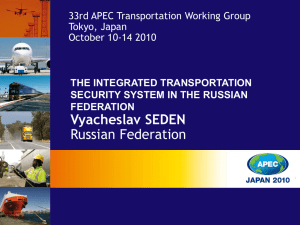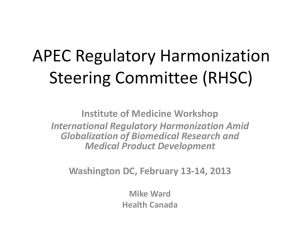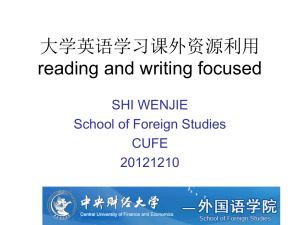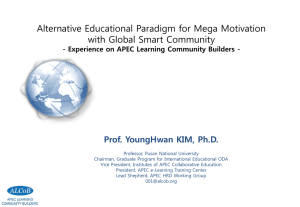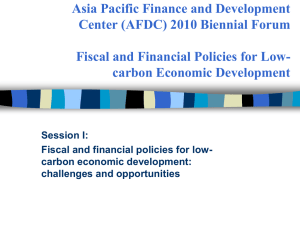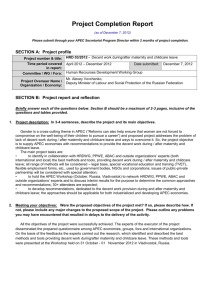EWG 09 10A CR
advertisement
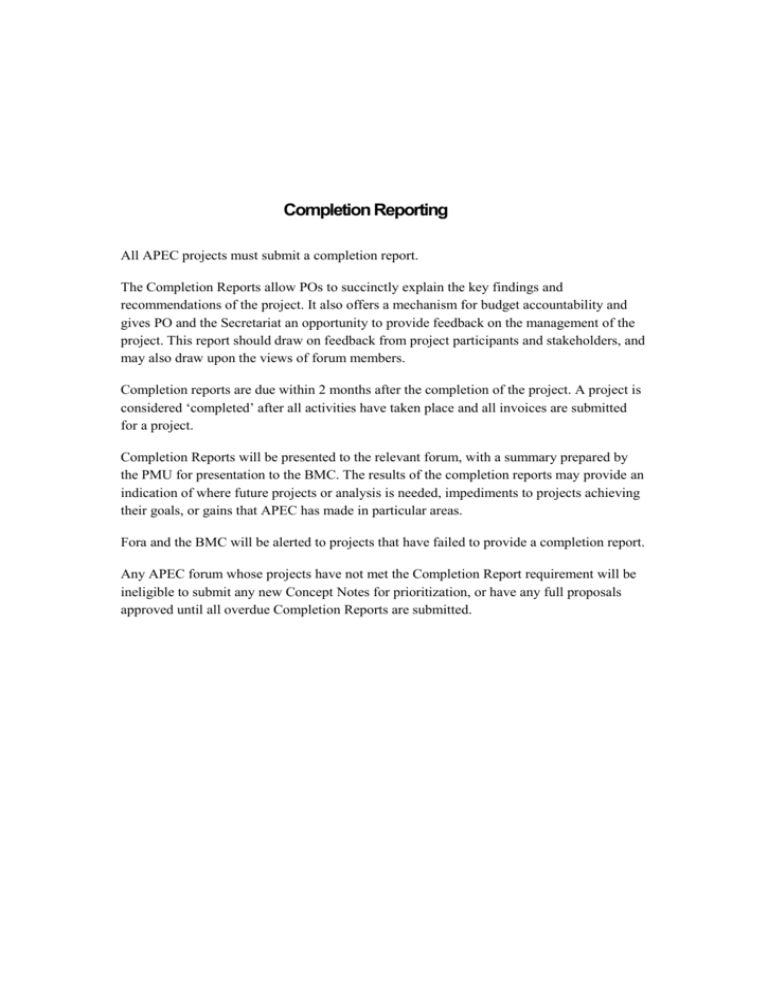
Completion Reporting All APEC projects must submit a completion report. The Completion Reports allow POs to succinctly explain the key findings and recommendations of the project. It also offers a mechanism for budget accountability and gives PO and the Secretariat an opportunity to provide feedback on the management of the project. This report should draw on feedback from project participants and stakeholders, and may also draw upon the views of forum members. Completion reports are due within 2 months after the completion of the project. A project is considered ‘completed’ after all activities have taken place and all invoices are submitted for a project. Completion Reports will be presented to the relevant forum, with a summary prepared by the PMU for presentation to the BMC. The results of the completion reports may provide an indication of where future projects or analysis is needed, impediments to projects achieving their goals, or gains that APEC has made in particular areas. Fora and the BMC will be alerted to projects that have failed to provide a completion report. Any APEC forum whose projects have not met the Completion Report requirement will be ineligible to submit any new Concept Notes for prioritization, or have any full proposals approved until all overdue Completion Reports are submitted. AP P E N D I X G COMPLETION REPORT Project Completion Report Please submit through your APEC Secretariat Program Director within 2 months of project completion. SECTION A: Project profile Project number & title : EWG09/2010A, APEC Low Carbon Model Town (LCMT) Project Phase 1 Time period covered in 1 January 2011 – 30 November report: Date submitted: 2011 27 January 2012 Committee / WG / Fora: Energy Working Group Project Overseer Name: Ryo Minami, Director, International Affairs Division, Agency for Natural Organization / Economy Resources and Energy, METI, Japan SECTION B: Project report and reflection Briefly answer each of the questions below. Section B should be a maximum of 2-3 pages, inclusive of the questions and tables provided. 1. Project description: In 3-4 sentences, describe the project and its main objectives. The LCMT project directly responds to the declaration at the 9th APEC Energy Ministers Meeting (EMM9), held in Fukui, Japan on 19 June 2010, which focused on “Low Carbon Paths to Energy Security”. The LCMT project seeks to promote low-carbon technologies in city planning in order to manage rapidly growing energy consumption and greenhouse gas emissions especially in urban areas of the APEC region. It consists of three activities, namely, i) development of “the Concept of the Low-Carbon Town in the APEC Region”, ii) Feasibility Study (FS) and iii) Policy Review of planned low-carbon town development projects. Under the LCMT Phase 1, Yujiapu Central Business District (CBD) Project in Tianjin, China was selected as the first case of low carbon town development project. 2. Meeting your objectives: Describe how the project went, with reference to the objectives laid out in your project proposal. Include any major changes to your project as proposed and any problems or obstacles that you encountered and how you overcame them. “The Concept of the Low-Carbon Town in the APEC Region” was developed through a preparatory study by the team of Japanese low carbon town experts and the review on the preparatory study by Study Group A. Study Group A consisted of experts from China, Indonesia, Malaysia, Philippine, Thailand, Chinese Taipei and Viet Nam. Study Group A made site visits in June 2011 to study best practices being implemented in the low carbon town projects in Da Nan in Viet Nam, Surabaya in Indonesia, Cebu in Philippine, Putrajaya in Malaysia and Tianjin, China. The feasibility study for Yujiapu Central Business District (CBD) Project in Tianjin, China was conducted by Nikken Sekkei, a consultant, who was selected through an international tender in February 2011. In the feasibility study, CO2 emission reduction targets were set, and a number of proper indicators were selected to evaluate the effect of low carbon measures for Yujiapu Central Business District (CBD) Project. The set of low carbon measures selected covered a wide range of categories including low carbon urban structure, building, traffic on energy demand side as well as area energy network, untapped energy, AP P E N D I X G COMPLETION REPORT renewable energy on energy supply side. Examination of cost performance for low carbon development was also conducted. The policy review was conducted by a team of experts from China, Thailand, Chinese Taipei, United States, Viet Nam and APERC. The review team visited Tianjin from 30 August to 1 September 2011, and had comprehensive discussions with representatives and experts from government agencies, private and state companies. Based on these discussions, 32 recommendation were made in the wide areas including emission reduction goals, transportation system, underground space, regional cool and heat supply system, energy saving buildings, heat island analysis, energy management system, low carbon construction and regional water system. These three activities were completed as planned, and outcomes were presented at the LCMT workshop held in conjunction with APEC EWG 42 meeting held in Kaohsiung, Chinese Taipei in October 2011. There were no problems or obstacles encountered. But, the project end date was extended by two months from the end of September to the end November 2011 in order to accommodate the project approval process which needs presentation of the project outputs at the EWG meeting. 3. Project evaluation: Describe how you evaluated the project and provide some details on the results of the evaluation (e.g. participant evaluation, peer review of publication, measurement of indicators, statistics demonstrating use of outputs etc.). When outcomes of the “the Concept of the Low Carbon Town in the APEC region, ”Yujiapu CBD feasibility study and its policy review were presented at the LCMT workshop held in conjunction with EWG 42 meeting, in Kaohsiung, Chinese Taipei, more than 160 delegates from member economies and experts including municipal officials attended the workshop, and lively discussions were made about the way low carbon town development should proceed. When draft reports of these studies were presented at APEC Low Carbon Model Town Forum in Tianjin, China June 2011, they got a lot of attention from the audience which amounted to more than 100 officials, experts and business representatives from APEC member countries. From these facts, LCMT project Phase 1 will be evaluated successful. It is also to be noted that FS report and the Policy Review report received high evaluation from the relevant government and municipality officials responsible for Yujiapu Central Business District (CBD) Project in Tianjin, China. 4. Key findings: Describe one or two examples of important findings arising from the project (e.g. results from surveys or case studies, insights provided by participants or experts, policy recommendations, roadblocks to progress on an issue etc.). One of the key findings will be the clear CO2 reduction target specified for the Yujiapu CBD low carbon development project, which is 30% in 2020 and 50% in 2030 respectively against business as usual case. These targets are supported by a set of concrete low carbon measures both on energy demand and supply side based on the comprehensive and systematic evaluation. 32 numbers policy recommendations are also the other example of findings, which are helpful to overcome barriers for the success of the Yujiapu CBD low carbon development project. 5. Next steps: Describe any follow-up steps or projects that you recommend. Have you already planned or begun these? What role could APEC play in any follow-up? AP P E N D I X G COMPLETION REPORT One of the next steps is to further refine the initial version of “The Concept of the Low-Carbon Town in the APEC region” , which was developed under LCMT Phase 1 in order to make it more useful guidebook for governments officials and low carbon town planers. The second case of low carbon town development project has already been selected. The other important next step will be encourage member economies to nominate candidate low carbon development towns for the third case of LCMT project, taking the advantage of the momentum being gathered toward low carbon path in the town level in many APEC economies. 6. Feedback for the Secretariat: Do you have any suggestions for more effective management of projects in the future? Any assessment of consultants, experts or participants that you would like to share? (The Secretariat collates and examines feedback to identify trends for ongoing evaluation of our project management and/or communications systems.) 7. Participant information: Please provide details, where applicable. Insert rows as needed. Economy China # male # female Details Mr. Yong LU (Water & Wastewater Segment EE Consultant, Schneider Electric, China) Mr. Meng Xu (Tianjin Innovative Finance Investment Co., Ltd) Indonesia Mr. Eko Budi Santoso (Institute of Technology Sepuluh Nopember Surabaya) Malaysia Ms. Punitha Silivarajoo (Ministry of Energy, Green Technology and Water) Philippine Ms. Lilian C. Fernandez (DOE) Ms. Hershey T. Dela Cruz (DOE) Ms. Caroline Quitaleg (DOE) Thailand Dr. Twarath Sutabutr (DEDE, Ministry of Energy) Dr. Sorawit (DEDE, Ministry of Energy) Dr. Samai Jai-in (National and Materials Technology Centre) Chinese Taipei Dr. Yie-Zu Robert HU (ITRI) Viet Nam United States Mr. Pham Sinh Thanh (MOIT) Mr. Do Thanh Vinh (MOIT) Dr. Patric Sherry (National Centre for Intermodal Transportation, University of Denver, United States) Japan Mr. Michinaga Kohno (Hitachi) AP P E N D I X G COMPLETION REPORT 8. Outputs: Please provide details, where applicable. # planned # actual # of workshops / events Details APEC Low Carbon Model Town Forum (Tianjin , China June 2011) LCMT Work Shop (Kaosiung, Chinese Taipei, Oct 2011) # of publications distributed 26 copies of “Concept of Low Carbon Town in the APEC Region” were printed. They will be distributed in due course. 11 copies of Feasibility Study for Yujiapu CBD were printed. They will be distributed in due course. # of CDs distributed # of websites created “The Concept of the Low-Carbon Town in the APEC Region” was uploaded at APEC and APERC website. The feasibility study for Yujiapu CBD Project was uploaded on APEC website. The policy review of Yujiapu CBD Project was uploaded on APERC website. Other: SECTION C: Budget Attach a detailed breakdown of the APEC- provided project budget, including: Planned costs (using most recently approved budget figures) Actual expenditures Variance notes: An explanation of any budget line under- or over-spent by 20% or more. SECTION D: Appendices or additions Please attach any of the following. This information will help us better understand your project, support overseers of similar projects and plan for future projects. List of experts or consultants utilised, with job titles and contact details List of participants, with job titles and contact details Event agendas Links to any relevant websites or online material (e.g. reports, resources created) Results of participant feedback or other project evaluation (raw and/or analysed) AP P E N D I X G COMPLETION REPORT Any other relevant information or resources that would help us learn more about your project FOR APEC SECRETARIAT USE ONLY APEC comments: Were APEC project guidelines followed? Could the project have been managed more effectively or easily by the PO? PD had the opportunity to attend the workshop where the results of LCMT Phase 1 were presented and, as the PO says, more than one hundred delegates attended the event. This project is one of those APEC Leaders and APEC Ministers of Energy have encouraged improving on aspects of energy efficiency and low carbon. The Yujiapu District in Tianjin, China, was selected to be the first pilot city of this successful research where different aspects of energy efficiency have been studied to enhance the quality of life on different aspects such a low carbon urban structure, building, traffic on energy demand side as well as an area energy network, untapped energy, renewable energy on energy supply side and smart grids. Till this moment, this very successful project is having a second part –or Phase II- and Samui Island in Thailand have been selected to carry out the several activities that implies the project.
